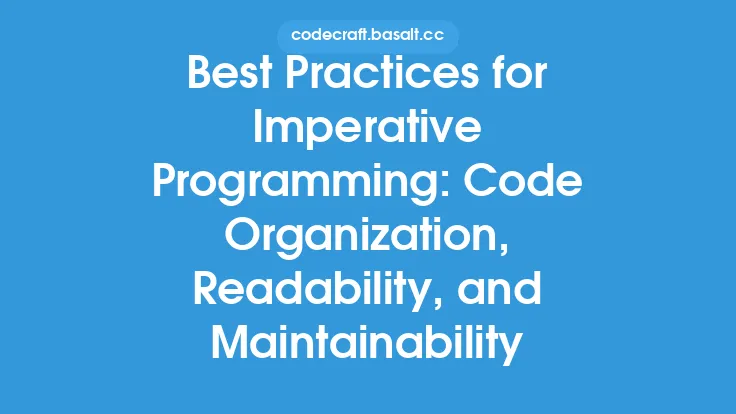When integrating aspect-oriented programming (AOP) into existing codebases, it's essential to follow best practices to ensure a smooth transition and maximize the benefits of AOP. AOP is a programming paradigm that aims to increase modularity by allowing the separation of cross-cutting concerns, such as logging, security, and caching, from the core business logic. By applying AOP principles to existing codebases, developers can improve maintainability, scalability, and reusability.
Understanding the Existing Codebase
Before integrating AOP into an existing codebase, it's crucial to understand the current architecture, design patterns, and coding conventions used in the project. This includes identifying the core business logic, cross-cutting concerns, and areas where AOP can bring the most value. A thorough analysis of the codebase will help developers determine the best approach for introducing AOP and minimize potential disruptions to the existing code.
Choosing the Right AOP Framework or Library
Selecting the right AOP framework or library is critical to the success of the integration process. There are various AOP frameworks and libraries available, each with its strengths and weaknesses. Developers should consider factors such as compatibility with the existing programming language and framework, ease of use, performance overhead, and community support. Popular AOP frameworks and libraries include AspectJ, Spring AOP, and JBoss AOP. It's essential to evaluate these options carefully and choose the one that best fits the needs of the project.
Identifying Cross-Cutting Concerns
Cross-cutting concerns are aspects of the system that cut across multiple modules or components, such as logging, security, and caching. Identifying these concerns is critical to applying AOP effectively. Developers should analyze the existing codebase to identify areas where cross-cutting concerns are scattered throughout the code, making it difficult to maintain and modify. By identifying these concerns, developers can create aspects that modularize and encapsulate the cross-cutting behavior, making it easier to manage and reuse.
Designing and Implementing Aspects
Once the cross-cutting concerns have been identified, developers can design and implement aspects to modularize and encapsulate the corresponding behavior. Aspects should be designed to be reusable, modular, and easy to maintain. Developers should follow established design patterns and principles, such as the Single Responsibility Principle (SRP) and the Open-Closed Principle (OCP), to ensure that aspects are loosely coupled and highly cohesive. Aspects can be implemented using various techniques, such as aspect-oriented programming languages, frameworks, or libraries.
Integrating Aspects into the Existing Codebase
Integrating aspects into the existing codebase requires careful planning and execution. Developers should start by introducing aspects into small, isolated areas of the codebase, such as logging or security, and gradually expand to other areas. It's essential to ensure that the aspects are properly woven into the existing code, using techniques such as compile-time weaving, load-time weaving, or runtime weaving. Developers should also consider using aspect-oriented programming tools, such as aspect compilers and weavers, to simplify the integration process.
Testing and Validating Aspects
Thorough testing and validation are critical to ensuring that aspects are working correctly and not introducing unintended behavior or side effects. Developers should write unit tests, integration tests, and system tests to verify that aspects are functioning as expected. Testing should include scenarios where aspects are enabled and disabled, as well as edge cases and error conditions. By thoroughly testing and validating aspects, developers can ensure that the introduction of AOP does not compromise the stability or reliability of the existing codebase.
Refactoring and Maintaining the Codebase
After integrating aspects into the existing codebase, it's essential to refactor and maintain the code to ensure that it remains modular, scalable, and maintainable. Developers should continuously monitor the codebase for areas where aspects can be improved or optimized, and refactor the code as needed to ensure that it remains consistent with AOP principles. Regular maintenance and refactoring will help prevent technical debt and ensure that the codebase remains adaptable to changing requirements and evolving business needs.
Best Practices and Recommendations
To ensure a successful integration of AOP into an existing codebase, developers should follow best practices and recommendations, such as:
- Start small and introduce aspects gradually
- Use established design patterns and principles
- Follow a consistent naming convention and coding standard
- Use aspect-oriented programming tools and frameworks
- Thoroughly test and validate aspects
- Continuously refactor and maintain the codebase
- Monitor and analyze the performance overhead of aspects
By following these best practices and recommendations, developers can ensure a smooth transition to AOP and maximize the benefits of this programming paradigm.





